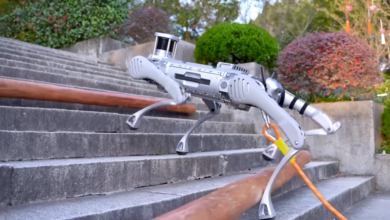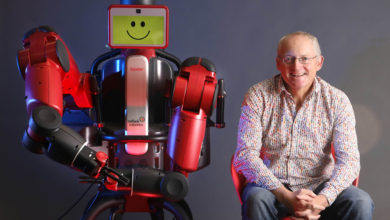Video Friday: SpaceHopper

Video Friday is your weekly selection of awesome robotics videos, collected by your friends at IEEE Spectrum robotics. We also post a weekly calendar of upcoming robotics events for the next few months. Please send us your events for inclusion.
RoboCup German Open: 17–21 April 2024, KASSEL, GERMANY
AUVSI XPONENTIAL 2024: 22–25 April 2024, SAN DIEGO
Eurobot Open 2024: 8–11 May 2024, LA ROCHE-SUR-YON, FRANCE
ICRA 2024: 13–17 May 2024, YOKOHAMA, JAPAN
RoboCup 2024: 17–22 July 2024, EINDHOVEN, NETHERLANDS
Enjoy today’s videos!
In the SpaceHopper project, students at ETH Zurich developed a robot capable of moving in low gravity environments through hopping motions. It is intended to be used in future space missions to explore small celestial bodies.
The exploration of asteroids and moons could provide insights into the formation of the universe, and they may contain valuable minerals that humanity could use in the future.The project began in 2021 as an ETH focus project for bachelor’s students. Now, it is being continued as a regular research project. A particular challenge in developing exploration robots for asteroids is that, unlike larger celestial bodies like Earth, there is low gravity on asteroids and moons. The students have therefore tested their robot’s functionality in zero gravity during a parabolic flight. The parabolic flight was conducted in collaboration with the European Space Agency as part of the ESA Academy Experiments Programme.
[ SpaceHopper ]It’s still kind of wild to me that it’s now possible to just build a robot like Menteebot. Having said that, at present it looks to be a fairly long way from being able to usefully do tasks in a reliable way.
[ Menteebot ]
Look, it’s the robot we all actually want!
[ Github ]
I wasn’t quite sure what made this building especially “robot-friendly” until I saw the DEDICATED ROBOT ELEVATOR.
[ NAVER ]
We are glad to announce the latest updates with our humanoid robot CL-1. In the test, it demonstrates stair climbing in a single stride based on real-time terrain perception. For the very first time, CL-1 accomplishes back and forth running, in a stable and dynamic way!
[ LimX Dynamics ]
EEWOC [Extended-reach Enhanced Wheeled Orb for Climbing] uses a unique locomotion scheme to climb complex steel structures with its magnetic grippers. Its lightweight and highly extendable tape spring limb can reach over 1.2 meters, allowing it to traverse gaps and obstacles much larger than other existing climbing robots. Its ability to bend allows it to reach around corners and over ledges, and it can transition between surfaces easily thanks to assistance from its wheels. The wheels also let it to drive more quickly and efficiently on the ground. These features make EEWOC well-suited for climbing the complex steel structures seen in real-world environments.
[ Paper ]
Thanks to its “buttock-contact sensors,” JSK’s musculoskeletal humanoid has mastered(ish) the chair-scoot.
[ University of Tokyo ]
Thanks, Kento!
Physical therapy seems like a great application for a humaonid robot when you don’t really need that humanoid robot to do much of anything.
[ Fourier Intelligence ]
NASA’s Ingenuity Mars helicopter became the first vehicle to achieve powered, controlled flight on another planet when it took to the Martian skies on 19 April 2021. This video maps the location of the 72 flights that the helicopter took over the course of nearly three years. Ingenuity far surpassed expectations—soaring higher and faster than previously imagined.
[ JPL ]
No thank you!
[ Paper ]
MERL introduces a new autonomous robotic assembly technology, offering an initial glimpse into how robots will work in future factories. Unlike conventional approaches where humans set pre-conditions for assembly, our technology empowers robots to adapt to diverse scenarios. We showcase the autonomous assembly of a gear box that was demonstrated live at CES2024.
[ Mitsubishi ]
Thanks, Devesh!
In November, 2023 Digit was deployed in a distribution center unloading totes from an AMR as part of regular facility operations, including a shift during Cyber Monday.
[ Agility ]
The PR2 just refuses to die. Last time I checked, official support for it ceased in 2016!
[ University of Bremen ]
DARPA’s Air Combat Evolution (ACE) program has achieved the first-ever in-air tests of AI algorithms autonomously flying a fighter jet against a human-piloted fighter jet in within-visual-range combat scenarios (sometimes referred to as “dogfighting”).In this video, team members discuss what makes the ACE program unlike other aerospace autonomy projects and how it represents a transformational moment in aerospace history, establishing a foundation for ethical, trusted, human-machine teaming for complex military and civilian applications.
[ DARPA ]
Sometimes robots that exist for one single purpose that they only do moderately successfully while trying really hard are the best of robots.
[ CMU ]
IEEE Spectrum




